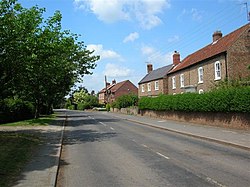Linton-on-Ouse: Difference between revisions
| Line 33: | Line 33: | ||
The village has a primary school. There is a village store and a public house, the College Arms, and there are several local businesses. | The village has a primary school. There is a village store and a public house, the College Arms, and there are several local businesses. | ||
The nearest villages are [[Newton-on-Ouse]] a mile to the south-east, [[Aldwark, Yorkshire|Aldwark]] 2½ miles to the north-west and [[Thorpe Underwood]] | The nearest villages are [[Newton-on-Ouse]] a mile to the south-east, [[Aldwark, Yorkshire|Aldwark]] 2½ miles to the north-west and [[Thorpe Underwood, Yorkshire|Thorpe Underwood]] two miles to the south-west. Sandwath Beck joins Shorn Dike to the north-east of the village before flowing into the [[River Kyle]] just to the east of the school. | ||
The 1881 UK Census recorded the population as 296.<ref name="Bulmers">{{cite book|title=Bulmer's Topography, History and Directory (Private and Commercial) of North Yorkshire 1890 |pages=767, 768|year=1890 |publisher=S&N Publishing|isbn=1-86150-299-0|accessdate=11 November 2012}}</ref> The 2001 UK Census recorded the population as 1,024, of which 723 were over the age of sixteen years old. There were 388 dwellings, of which 134 were detached.<ref>{{cite web|url=http://neighbourhood.statistics.gov.uk/dissemination/LeadDatasetList.do?a=7&b=797739&c=linton-on-ouse+cp&d=16&g=475653&i=1001x1003&m=0&r=1&s=1357393635978&enc=1&domainId=15|title=2001 UK Census|accessdate=5 January 2013}}</ref> | The 1881 UK Census recorded the population as 296.<ref name="Bulmers">{{cite book|title=Bulmer's Topography, History and Directory (Private and Commercial) of North Yorkshire 1890 |pages=767, 768|year=1890 |publisher=S&N Publishing|isbn=1-86150-299-0|accessdate=11 November 2012}}</ref> The 2001 UK Census recorded the population as 1,024, of which 723 were over the age of sixteen years old. There were 388 dwellings, of which 134 were detached.<ref>{{cite web|url=http://neighbourhood.statistics.gov.uk/dissemination/LeadDatasetList.do?a=7&b=797739&c=linton-on-ouse+cp&d=16&g=475653&i=1001x1003&m=0&r=1&s=1357393635978&enc=1&domainId=15|title=2001 UK Census|accessdate=5 January 2013}}</ref> | ||
Latest revision as of 23:43, 5 February 2024
| Linton-on-Ouse | |
| Yorkshire North Riding | |
|---|---|
 Linton on Ouse | |
| Location | |
| Grid reference: | SE493607 |
| Location: | 54°2’26"N, 1°14’54"W |
| Data | |
| Population: | 1,201 (2011) |
| Post town: | YORK |
| Postcode: | YO30 2 |
| Local Government | |
| Council: | Hambleton |
| Parliamentary constituency: |
Thirsk and Malton |
Linton-on-Ouse is a village in the North Riding of Yorkshire, about eight miles north-west of York. It stands on the north bank of the River Ouse.
The River Ure becomes the River Ouse at Linton-on-Ouse. There is no new river joining the Ure to form a new name nor any obvious division between the streams though for convenience the change may be deemed to occur in the sharp bend known as Cuddy Shaw Reach, just south-west of the village.
History
The village is mentioned in the Domesday Book as Luctone in the Bulford hundred. The manor at this time was split between Thorfin of Ravensworth and Thorn of Linton. Afterwards the manor was granted to Robert of Mortain.[1] The manor passed to Thomas de Ros, 4th Baron de Ros in the 14th century and remained in their family until the mid-16th century. At the beginning of the 18th century the manorial rights were sold to University College, Oxford, which built a school in the village in 1871.[2][3]
In the mid-18th century, Acts of Parliament were passed to make the River Ouse navigable. This included the building of a lock at Linton-on-Ouse that is now a Grade II Listed Building.[4]
Since 1937 RAF Linton-on-Ouse has been home to a Royal Air Force station, RAF Linton-on-Ouse. Since 1957 the main role of the airfield has been the training of pilots.[5]
In the summer of 1960 and 1961, the perimeter track of the airfield was used to form the 1.7-mile Linton-on-Ouse Motor Racing circuit.[6]
About the village

The village has a primary school. There is a village store and a public house, the College Arms, and there are several local businesses.
The nearest villages are Newton-on-Ouse a mile to the south-east, Aldwark 2½ miles to the north-west and Thorpe Underwood two miles to the south-west. Sandwath Beck joins Shorn Dike to the north-east of the village before flowing into the River Kyle just to the east of the school.
The 1881 UK Census recorded the population as 296.[2] The 2001 UK Census recorded the population as 1,024, of which 723 were over the age of sixteen years old. There were 388 dwellings, of which 134 were detached.[7]
Outside links
| ("Wikimedia Commons" has material about Linton-on-Ouse) |
References
- ↑ Linton-upon-Ouse in the Domesday Book
- ↑ 2.0 2.1 Bulmer's Topography, History and Directory (Private and Commercial) of North Yorkshire 1890. S&N Publishing. 1890. pp. 767, 768. ISBN 1-86150-299-0.
- ↑ [1]
- ↑ Linton Lock at Linton on the Ouse - British Listed Buildings
- ↑ RAF Linton-on-Ouse
- ↑ Peter Swinger (2008). Motor Racing Circuits in England : Then & Now. Ian Allan Publishing. ISBN 0 7110 3104 5.
- ↑ "2001 UK Census". http://neighbourhood.statistics.gov.uk/dissemination/LeadDatasetList.do?a=7&b=797739&c=linton-on-ouse+cp&d=16&g=475653&i=1001x1003&m=0&r=1&s=1357393635978&enc=1&domainId=15. Retrieved 5 January 2013.
